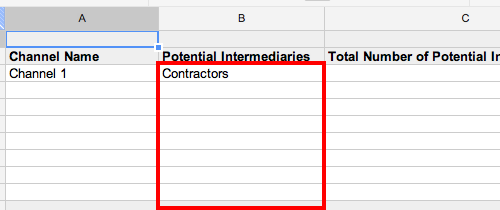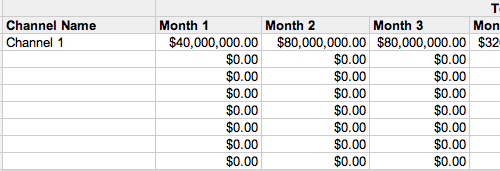How many times have you heard marketers talk about creating a distribution strategy?
…You can probably count the numbers of times on one hand.
The truth is, marketing “gurus” love to tell you how to promote your products. They get stuck on things like pay per click advertising and building a social media presence.
Now, I enjoy talking about the marketing and sales process just as much as the next guy, however, there’s certainly much more to marketing than simply promoting your product.
Great marketers know that, if you want to succeed, you need to have a sound marketing mix strategy that fits well within your overall business growth plan.
Of course, laying out your company’s distribution strategy won’t be the sexiest thing you’ve ever done as a business person.
But then again, who care’s about being sexy, right? …we just want to get paid.
Let’s dig in.
What is a distribution strategy?
Before we dig into the details, let’s first answer the obvious question, what exactly is a distribution strategy?
In simple terms, your distribution strategy lays out the details of how you plan to get your product in the hands of your customers.
Consider the traditional distribution model below.

In the distribution model above, let’s say that you’re the manufacturer. Your distribution strategy would identify which paths you intend to take in order to get your products to the end user.
You may decide to sell to wholesalers, retailers, or both.
Either way, you’ll need a strategy that identifies and outlines how you plan to move your product so you can generate the best return on your investment.
Step 1: Evaluate the end-user
Before you can sell to someone, you need to have a good understanding of what it is they want and how they want to go about buying it.
This comes down to conducting a little market research.
I won’t get into that much here, but start by asking yourself questions such as these:
- Does the end user need personalized service? If so, who is the best person to provide that service to them?
- Is the end user more likely to purchase this product online or at a physical store?
- How much will you need to educate the end user on your product? Who is in the best position to help you educate the end user?
Once you’ve evaluated the end user, start working your way backwards in the distribution model.
Keep in mind that, if you plan to have distribution partners, you’ll need to evaluate their needs as well.
Step 2: Identify potential marketing intermediaries
Once you have a clear understanding of your end user, it’s time to start crunching the numbers and laying out a game plan.
To help us speed things up, I created a spreadsheet. Feel free to make a copy and use it yourself.

The first thing we’ll need to do is to identify potential marketing intermediaries.
Generally speaking, there are only two ways for you to sell product to the end user:
- Directly – you can sell directly to the end user through a sales force.
- Indirectly – or you can sell indirectly to the end user through marketing intermediaries.
Marketing intermediaries, in short, help you sell your product to the end user.
You can typically group potential marketing intermediaries into a couple different categories:
- Agents and Brokers – Agents and brokers are marketing intermediaries that act, essentially, like an outsourced sales force. The main difference here is that agents and brokers don’t typically buy the product from you. Instead, they sell it for you and make a fee or commission.
- Wholesalers and Distributors – Wholesalers and distributors are marketing intermediaries who purchase product in bulk from the manufacturer and store it until they can sell it to retailers or contractors at a profit.
- Retailers – Retailers typically purchase products from wholesalers/distributors and resell it to contractors and end users.
- Value Added Resellers – And lastly, value added resellers such as contractors typically purchase products, bundle them within their service, and sell it to the end user.
Take a few minutes to brainstorm potential marketing intermediaries and enter them into the spreadsheet along with the additional information needed.

Under the “revenue projections” tab, you should see that the revenue projections were automatically calculated for you. This information will be important for measuring your progress.
Step 3: Research potential marketing intermediares
Once you’ve identified several marketing intermediaries that you think you could possibly partner with, start doing your research to see what you can find.
If you can, reach out to these potential distribution partners and offer to buy them a cup of coffee.
Get to know them and consider what type of business relationship the partnership could turn into.
The point here is to make sure that you really get to know them…more than just what’s written on paper.

Use the “research intermediares” tab to keep track of these potential partners.
Here are a few questions that you may want to consider asking:
- What are some ways that you think we may be able to partner?
- What are some of your weaknesses that we could potentially address?
- What are some of your strengths that we may be able to take advantage of?
- Who would you sell to and at what markup?
Step 4: Narrow in on the profitable distribution channels
Now that we have a good idea of who would make for a good distribution partner, we now need to find which types of distribution channels are available and then narrow in on the most profitable distribution channels.
Remember, as with anything, your distribution program is going to cost you money so the idea is to find distribution channels that generate the best return on your investment.
Distribution channels are, essentially, paths that you push your products through. In most cases, it’s common to have multiple channels of distribution that you manage. Different channels of distribution may have different sets of marketing intermediaries who help you move your product.
Distribution can typically be grouped into three primary categories:
- Intensive distribution – intensive distribution means there are a lot of intermediaries. An example of intensive distribution may be snack foods; one product may be stocked in many stores and may have many different channels of distribution.
- Selective distribution – selective distribution means there are a few intermediaries. An example of selective distribution might be a particular type of fruit that is only sold within a certain geographical area.
- Exclusive distribution – exclusive distribution means only a few intermediaries and those intermediaries have to carry only their products. An example of exclusive distribution might be high end fashion products that are only sold in very specific stores.
The types of distribution channels you will be able to utilize will differ slightly depending on where you are in the distribution model and who you are trying to sell to.
For example, if your end user is the typical consumer, the types of distribution channels available may look something like this..

If you sell to business users, the types of distribution channels may be slightly different…

And lastly, if you provide a service, the types of distribution channels would probably resemble something like this…

By now you should, at least, have an idea of which distribution channels are likely to have the most potential.
To back up those assumptions with proof, go into the “channel pricing” tab and enter in the markups of your distribution partners.

Next, enter in how much it cost you to make the product and your desired profit margin.

Once you have those details figured out, it’s time to negotiate the numbers with your distribution partners.
Keep in mind that your distribution partners are, essentially, you’re customers. Of course, in this case, your customer’s goal is to make money. That means that you need to work with them to come up with a mutually beneficial agreement so you can both make money.
Step 5: Manage your channels of distribution
As with any investment, you’re going to need to manage your channels of distribution to make sure that you are maximizing your return on investment.
Make sure that you track the progress of each distribution channel against the goals that you laid out in the previous steps.
If a distribution channel starts to under perform, meet with your distribution partners and figure out where the leak is in your distribution model.
More importantly, determine how you can get things back on track and optimize each channel of distribution.
You need to predictably be able to make progress.
Conclusion
As I mentioned earlier, laying out your company’s distribution strategy won’t be the sexiest thing you’ve ever done as a business person.
The truth is, however, sometimes putting funds into improving your distribution strategy is a better investment than simply throwing more money at promotion.
That means that we’ll need to take a minute to crunch the numbers.
Hopefully this post has helped with that.
What are some ways you can improve your distribution strategy?
